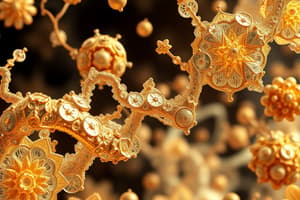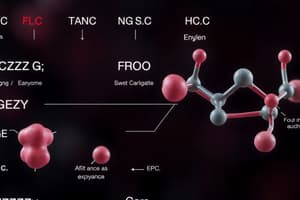Podcast
Questions and Answers
What is the primary function of enzymes in biological reactions?
What is the primary function of enzymes in biological reactions?
- To speed up reactions that would normally occur too slowly (correct)
- To completely change the reaction mechanism
- To consume substrates during the reaction
- To increase the temperature of the reaction
Which component is necessary for a complex enzyme to function?
Which component is necessary for a complex enzyme to function?
- Cofactor (correct)
- Active site
- Substrate
- Holoenzyme
What term describes the inactive form of an enzyme that is missing a necessary cofactor?
What term describes the inactive form of an enzyme that is missing a necessary cofactor?
- Apoenzyme (correct)
- Holoenzyme
- Active site
- Substrate
How does the induced fit model describe enzyme action?
How does the induced fit model describe enzyme action?
Which of the following best describes the specificity of enzymes?
Which of the following best describes the specificity of enzymes?
Which metals are commonly found as inorganic cofactors in enzymes?
Which metals are commonly found as inorganic cofactors in enzymes?
What is the role of the active site in an enzyme?
What is the role of the active site in an enzyme?
Which of the following statements is false regarding enzymes?
Which of the following statements is false regarding enzymes?
What is the function of enzymes regarding activation energy?
What is the function of enzymes regarding activation energy?
What is the significance of ΔG being negative in an exothermic reaction?
What is the significance of ΔG being negative in an exothermic reaction?
What happens to an enzyme if the temperature exceeds its optimal level?
What happens to an enzyme if the temperature exceeds its optimal level?
At high substrate concentrations, what is the limitation on enzyme activity?
At high substrate concentrations, what is the limitation on enzyme activity?
Why do enzymes have specific pH levels at which they function optimally?
Why do enzymes have specific pH levels at which they function optimally?
How does an increase in temperature generally affect a chemical reaction?
How does an increase in temperature generally affect a chemical reaction?
What is the role of cofactors in enzyme activity?
What is the role of cofactors in enzyme activity?
Which statement accurately describes the relationship between substrate concentration and reaction rate?
Which statement accurately describes the relationship between substrate concentration and reaction rate?
What type of reaction requires an initial input of energy to break bonds?
What type of reaction requires an initial input of energy to break bonds?
Which of the following enzymes would function best at a low pH?
Which of the following enzymes would function best at a low pH?
What does the term 'enzyme saturation' refer to?
What does the term 'enzyme saturation' refer to?
How does enzyme catalysis affect the transition state of a reaction?
How does enzyme catalysis affect the transition state of a reaction?
When studying enzyme activity, which environmental factor can significantly reduce reaction rates if not optimal?
When studying enzyme activity, which environmental factor can significantly reduce reaction rates if not optimal?
Flashcards
Enzyme
Enzyme
A biological catalyst that speeds up the rate of reactions, but is not consumed in the process.
Catalyst
Catalyst
A chemical agent that influences the speed of a reaction without getting used up.
Enzyme Composition
Enzyme Composition
Almost all enzymes are made up of proteins, often folded into complex structures.
Simple Enzyme
Simple Enzyme
Signup and view all the flashcards
Complex Enzyme
Complex Enzyme
Signup and view all the flashcards
Apoenzyme
Apoenzyme
Signup and view all the flashcards
Holoenzyme
Holoenzyme
Signup and view all the flashcards
Active Site
Active Site
Signup and view all the flashcards
Exothermic Reaction
Exothermic Reaction
Signup and view all the flashcards
Activation Energy
Activation Energy
Signup and view all the flashcards
Change in Free Energy (ΔG)
Change in Free Energy (ΔG)
Signup and view all the flashcards
Substrate
Substrate
Signup and view all the flashcards
Enzyme Specificity
Enzyme Specificity
Signup and view all the flashcards
How Enzymes Catalyze Reactions
How Enzymes Catalyze Reactions
Signup and view all the flashcards
Substrate Concentration and Reaction Rate
Substrate Concentration and Reaction Rate
Signup and view all the flashcards
Temperature and Enzyme Activity
Temperature and Enzyme Activity
Signup and view all the flashcards
pH and Enzyme Activity
pH and Enzyme Activity
Signup and view all the flashcards
Factors Affecting Reaction Rate
Factors Affecting Reaction Rate
Signup and view all the flashcards
Cofactors
Cofactors
Signup and view all the flashcards
Competitive Inhibitor
Competitive Inhibitor
Signup and view all the flashcards
Non-competitive Inhibitor
Non-competitive Inhibitor
Signup and view all the flashcards
Enzyme Regulation
Enzyme Regulation
Signup and view all the flashcards
Study Notes
Enzyme Mechanisms and Function
- Enzymes are biological catalysts, speeding up reactions essential for life that would otherwise proceed too slowly.
- Catalysts change reaction rates without being consumed; enzymes are unaffected and reusable.
- Almost all enzymes are proteins (tertiary or quaternary structure).
- Enzymes lower activation energy, enabling reactions to occur.
- They are not consumed in the reaction.
- Enzymes have active sites that bind specific substrates, forming enzyme-substrate complexes.
Enzyme Types
- Simple enzymes are composed only of proteins.
- Complex enzymes need a cofactor besides the protein component.
- Apoenzyme: inactive form lacking the cofactor.
- Holoenzyme: active form with the cofactor.
Cofactors and Coenzymes
- Cofactors are inorganic metal ions (e.g., Zn, Fe, Cu), crucial enzyme function.
- Coenzymes are organic molecules, often derived from water-soluble vitamins (e.g., NAD+ from niacin).
Enzyme Components and Function
- Enzymes act on substrates at their active sites.
- Substrate: the reactant acted upon by the enzyme.
- Active site: a binding pocket with a catalytic center, converting substrate to product.
- The induced fit model describes how enzyme shape changes upon substrate binding for a tighter fit, optimal catalysis.
Enzyme Specificity
- Reaction Specificity: Enzymes catalyze one specific chemical reaction (e.g., sucrase hydrolyzes sucrose).
- Forward and Reverse Reactions: Many metabolic enzymes catalyze reactions in both directions.
- Substrate Specificity: Enzymes recognize a particular set of substrates essential for their specific reactions (e.g., sucrase binds sucrose, water, glucose, and fructose).
Enzyme Names
- Enzyme names typically end in "-ase".
- The root signifies the reaction type or product generated. (e.g., ATPase).
Exothermic Reactions
- Exothermic reactions release energy during reaction
- Requires energy input to break bonds in reactants prior to releasing energy.
- Energy comes from thermal sources.
Activation Energy
- Activation energy (EA) is the energy needed to surpass the transition state, where reactant molecules become unstable.
- Thermal agitation increases molecular speed and collision strength, facilitating reactions.
- Transition state is peak of activation energy.
- Bonds are eventually broken, and new ones form.
Change in Free Energy (ΔG)
- ΔG is the difference in free energy between products and reactants.
- ΔG is negative for exothermic reactions.
- Enzymes do not alter ΔG. but they help reactions reach equilibrium faster.
Factors Affecting Enzyme Activity
- Enzymes lower activation energy (EA) by facilitating the transition state.
- Reduced temperature requirements speed up reaction rates.
- Limitations:
- Substrate concentration
- Temperature
- pH
- Cofactor availability.
Substrate Concentration
- Low substrate concentration: rate directly correlates with substrate concentration.
- High substrate concentration: enzyme saturation occurs, and increasing substrate concentration has little effect on rate other than enzyme saturation.
Temperature
- Higher temperature increases enzymatic reaction rates due to increased molecular movement and collisions.
- Optimal temperature exists for each enzyme.
- High temperatures cause enzyme denaturation, halting enzyme activity.
pH
- Each enzyme has an optimal pH range.
- Deviating from optimal pH disrupts the active site causing enzyme denaturation. and halts activity.
- Stomach enzymes (e.g., pepsin) function optimally at low pH, whereas intestinal enzymes (e.g., trypsin) function optimally at higher pH.
Studying That Suits You
Use AI to generate personalized quizzes and flashcards to suit your learning preferences.




